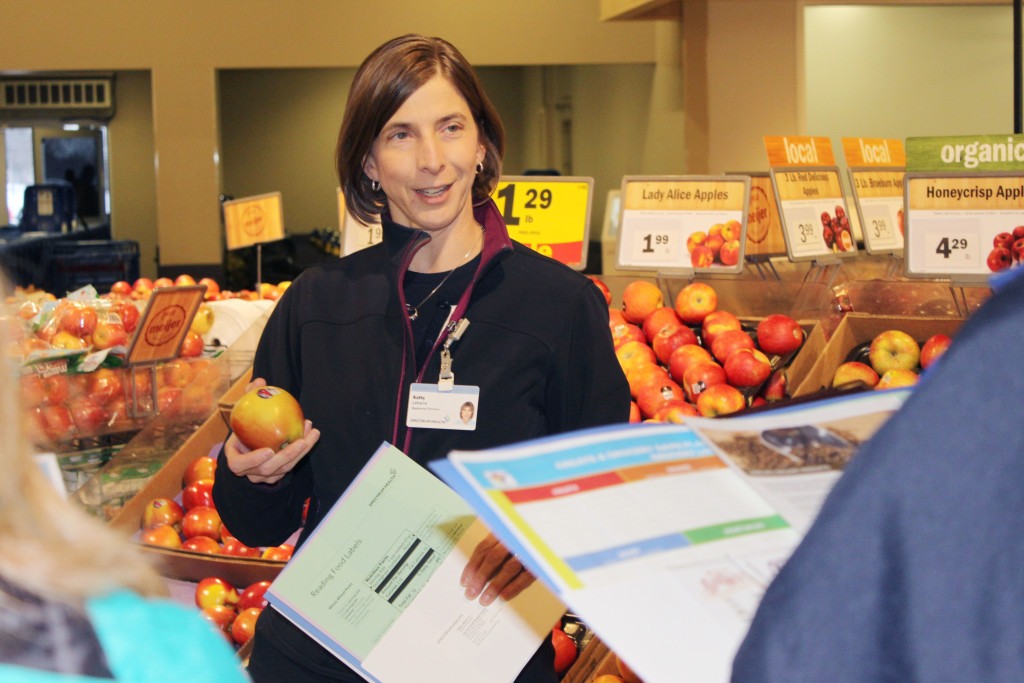
When you have to follow a special diet, grocery shopping can be overwhelming.
Which of the options on the shelves are best for you? And how do you find things that taste good—especially if they’re not what you’re used to eating?
Now you can get hands-on, in-store grocery help from a Spectrum Health dietitian.
In January, a pair of registered dietitians kicked off a series of grocery store tours to help people make smart food choices and get them thinking about eating in new ways. The program launched with two offerings:
- Shopping for a healthy heart
- Shopping for weight loss and diabetes prevention/management
Tours designed around other topics—eating gluten-free, fast-and-healthy foods and cooking for one—are in the works.
“When we meet with patients one on one, many of them say, ‘I wish I could take you shopping with me,’” said Kathy LeBarre, RDN, an outpatient dietitian at Spectrum Health Blodgett Hospital. She and Kristi Veltkamp, MS, RDN, developed the tours as a way to offer that service at a low cost.
Getting on track
When Jackie and Paul Madden of Grandville heard about the program, they jumped at the chance to get hands-on advice.
“It gets overwhelming. There’s a lot to know,” said Jackie, who is helping to change her family’s eating habits to support her husband’s complex dietary needs.
“Two years ago I had open-heart surgery,” Paul explained. “Then I got cancer. Going through the cancer and the chemo, I couldn’t eat what I was supposed to. … So now we’re trying to get back on track with the healthy eating.”
The Maddens were part of a small group that gathered at the Knapp’s Corner Meijer store on a snowy morning to take a healthy heart grocery tour.
Each participant received a folder packed with handouts—how-to instructions for reading food labels, choosing lean meats, choosing healthy fats, lowering your sodium intake, using herbs and spices, planning meals and more.
As the group walked from section to section—produce, deli, meat, dairy, frozen, baking, spices, oils, cereals—LeBarre gave a slew of tips and techniques. Her goal? Teach people what to look for on food labels and help them open up to new ways of eating.
“Being open to trying new things helps expand the world of eating,” LeBarre said.
Tips for reading Nutrition Facts labels:
- Check the listed amounts of saturated fat, sodium, sugar and fiber. Compare these numbers from product to product. But watch out—if the serving size on two products isn’t the same, you’ll have to do the math.
- Serving size matters. Does it match your typical portion size? If not, calculate your actual intake of sodium, fat, sugar, etc.
- Look for meat products marked lean or extra lean. Examining three packages of ground turkey, LeBarre pointed out big differences in fat content: 17 grams per 4-ounce serving for regular ground turkey, 8 grams for the lean version and only 1.5 grams for extra lean.
- Look for products marked low-sodium or lower-sodium—and then check the sodium content so you’ll know how much an item would contribute to your daily total.
- Avoid foods with saturated fats, which come from animal sources (meats and dairy). Look for mono fats, such as those found in olive oil, canola oil and avocados. These are the healthy fats.
- To increase your fiber intake, look for foods containing whole grains.
Tips for changing your eating habits:
- Unless your doctor has mandated drastic, immediate changes in your diet, try cutting back on problem ingredients gradually. You’ll be more likely to succeed.
- Beware of foods in the high-fat/high-sodium danger zone: butter/margarine, fatty meats and cheeses, fried foods, sauces, salad dressings, frozen dinners and other processed foods.
- Remember that if it’s in a box, it’s processed. And the more processed a food is, the more sodium and sugar it’s likely to have.
- To help reduce sodium intake, get the saltshaker off your dinner table. “Salt or sodium is an acquired taste, so the more you get it out of your diet, the less you’ll crave it,” LeBarre said.
- Experiment with new ways of flavoring your food. Try using herbs and spices instead of salt. Use flavored balsamic vinegars and flavored olive oils to add interest to salads, pastas and meats.
- Substitute whole wheat flour for some of the white flour in a recipe, or add flaxseed meal to oatmeal or home-baked goods.
- If you don’t have a kitchen scale, a rule of thumb is that a 3-ounce piece of meat is about the size of a deck of cards. Better yet? Buy an inexpensive kitchen scale.
- If you’re eating only food that’s good for you, but you’re gaining weight, control your portions. “The weight gain is coming from calories,” LeBarre said.
- Find new recipes using websites that let you filter based on dietary needs. Veltkamp gave Yummly.com as an example.
For the Maddens, the grocery tour paid off with new ideas for their healthy-eating journey.
“I like the knowledge,” Jackie said, noting that shopping and meal planning will be easier now.
 /a>
/a>
 /a>
/a>
 /a>
/a>
Sorry I missed notification of grocery store tours, would have liked to go on the weight loss one.
Luckily, Ron, you can still sign up for upcoming tours. Here’s a link to the full list of upcoming tours/classes. There’s a weight-loss one on there for the end of February. http://www.spectrumhealth.org/nutrition-classes-events